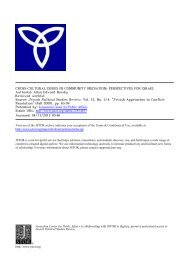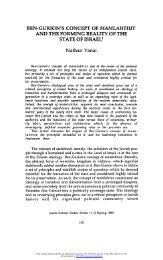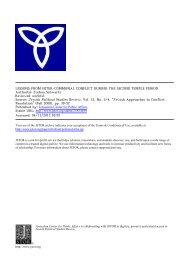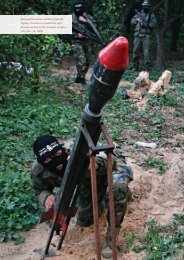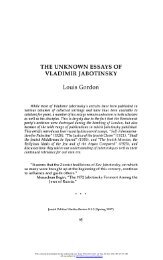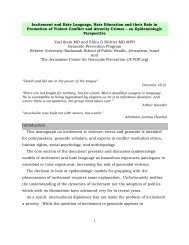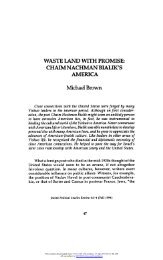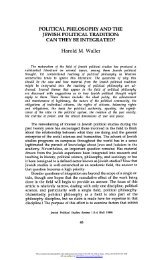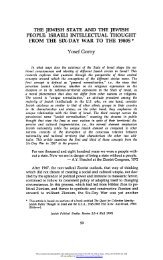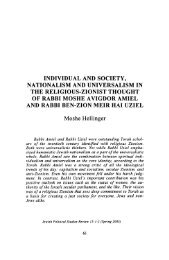the jewish community of cuba: between continuity and extinction
the jewish community of cuba: between continuity and extinction
the jewish community of cuba: between continuity and extinction
Create successful ePaper yourself
Turn your PDF publications into a flip-book with our unique Google optimized e-Paper software.
126 Margalit Bejaranoas <strong>the</strong> representative organ <strong>of</strong> <strong>the</strong> Jewish <strong>community</strong>, <strong>and</strong> its buildingreflected <strong>the</strong> transformation <strong>of</strong> Cuban Jews from <strong>the</strong>ir as apositiongroup <strong>of</strong> immigrants, strugglingfor survival in a foreign l<strong>and</strong>, to that <strong>of</strong>an established colony, well-rooted in <strong>the</strong> generalmiddle class. Thelarge building<strong>of</strong> <strong>the</strong> Patronato was divided <strong>between</strong> a beautiful modern synagogue <strong>and</strong> a social <strong>and</strong> cultural center, whose main hall had acapacity<strong>of</strong> 1,250 seats.40 The magnificent building,noticeable fromafar byits higharch <strong>and</strong> decorated with Jewish emblems, symbolized<strong>the</strong> self-deceptive tranquillity<strong>and</strong> confidence <strong>of</strong> <strong>the</strong> Jewish <strong>community</strong>in its future.Members <strong>of</strong> <strong>the</strong> Orthodox group, ga<strong>the</strong>redaround Adath Israel,preferredto erect <strong>the</strong>ir own buildingin Old Havana, where many <strong>of</strong><strong>the</strong>m still lived.41 On <strong>the</strong> corner <strong>of</strong> Picota <strong>and</strong> Acosta Streets <strong>the</strong>yconstructed a three-story building containinga large synagogue (600 seats),a reception hall, a small synagogue for <strong>the</strong> daily minyan,<strong>and</strong> a mikve.The building<strong>of</strong> <strong>the</strong> Patronato <strong>and</strong> <strong>the</strong> new Adath Israel served asmodels to <strong>the</strong> Sephardisector. Upperclass Sephardim livinginVedado <strong>and</strong> Miramar wished to establish a neworganizationthatwould fit <strong>the</strong>ir new social position. Theyfounded a new congregation,Centro Hebreo Sefaradi, that constructed a beautiful synagogue <strong>and</strong> social center on 17th <strong>and</strong> E Streets in Vedado. The building<strong>of</strong> <strong>the</strong> CentroSefaradi was accompanied by conflicts with <strong>the</strong> Sephardim <strong>of</strong> OldHavana who were faithful to <strong>the</strong> primacy<strong>of</strong> Chevet Ahim. However,<strong>the</strong> Castro Revolution occurred before <strong>the</strong> Sephardimhad time toproperly inaugurate<strong>the</strong>ir new center <strong>and</strong> to redefine <strong>the</strong> relationship<strong>between</strong> <strong>the</strong> new Centro Sefaradi <strong>and</strong> <strong>the</strong> old Chevet Ahim.The first Jewish organizationin Cuba, <strong>the</strong> United HebrewCongregation, was <strong>the</strong> last to be caught by <strong>the</strong> construction fever. In 1956, after<strong>the</strong> celebration <strong>of</strong> <strong>the</strong> congregation's fiftieth anniversary, AmericanJews were about to purchasea piece<strong>of</strong> l<strong>and</strong> on Miramar's Fifth Avenue<strong>and</strong> 32nd Street. Their projectnever materialized, however. When <strong>the</strong>Revolution occurred, American Jews were among <strong>the</strong> first to leave Cuba<strong>and</strong> return to <strong>the</strong> U.S., which<strong>the</strong>y considered as <strong>the</strong>ir homel<strong>and</strong>.The Attitude <strong>of</strong> <strong>the</strong> Revolutionary Governmenttoward <strong>the</strong> JewsThe Cuban Revolution, which took power on 1 January 1959, broughtabout <strong>the</strong> total destruction <strong>of</strong> <strong>the</strong> former economic, political <strong>and</strong> socialstructure in which <strong>the</strong> Jewish <strong>community</strong> had prospered.Nationalization <strong>of</strong> private business, economicprivations,<strong>and</strong> Fidel Castro's openidentification with Marxist-Leninistideology were among <strong>the</strong> causes<strong>of</strong> <strong>the</strong> large-scale emigration<strong>of</strong> upper <strong>and</strong> middle class CubansThis content downloaded by <strong>the</strong> authorized user from 192.168.72.230 on Sun, 2 Dec 2012 04:14:50 AMAll use subject to JSTOR Terms <strong>and</strong> Conditions



